The history of the United States has generally been written with the states in a subordinate role or cast in a negative light — but no longer. The story of America’s confrontation with the coronavirus pandemic is one in which states and their governors have been dominant.
As Washington has stumbled, governors of both parties have acted to fill the void. States have pleaded with Washington for help, and sometimes have gotten it. As often, however, the tensions and disagreements between state leaders and the federal government — especially with President Trump — have come to define the crisis.
Political Reckoning
As Trump dallied, governors moved on their own to order their residents to stay at home. When the president threatened to force states to lift those restrictions, governors resisted. When Trump supported protesters demanding that their states be opened up, many governors — though not all — said they would follow federal guidelines to the letter or even go beyond.
This display of state power is very much as the Founders intended when they established the nation. Just as they created checks and balances at the national level among the legislative, executive and judicial branches, they also wanted checks and balances between the central government and the states. Over time, the federal government has regularly usurped the broad authority given to the states, often to wipe away problems or correct historical injustices.
This spring, the balance of power has been flipped, with states forced to compensate for failings at the national level. Those federal deficiencies reflect an absence of readiness and sometimes a lack of interest and competence on the part of the Trump administration. The deficiencies have been compounded by a president given to issuing conflicting advice, attacking individual governors, and making wildly misleading and outright false statements, as when he suggested that scientists should explore injecting bleach into people to combat the virus.
“What I can say is we’ve had very little leadership with regard to the coronavirus crisis from the federal government,” said Illinois Gov. J.B. Pritzker (D). The first-term governor recently reviewed the history of presidential leadership in times of crisis. “Each of them understood the importance and power that the federal government has to move the country in a single direction toward victory,” he said. “I have seen nearly none of that out of this president.”
In contrast to past presidents, Trump has rhetorically claimed vast powers while making clear through his actions that he prefers a system that puts on governors the responsibility for some of the more difficult decisions.
Robert Chesney, a professor of law at the University of Texas at Austin, argued that rarely has the president claimed more power while doing less with it. “Some of the most over-the-top claims we’ve seen about the relationship between federal power and state power are happening at the same time that the federal government is shockingly inactive in areas it could and should be,” he said.
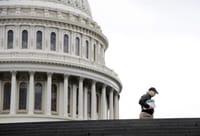
Power to the states
The word “federalism” does not appear in the Constitution, but it was always meant to be an essential component of the new American government established in the late 18th century.
“Federalism is the great constitutional compromise,” said Abbe Gluck, a professor at Yale Law School. “It’s the way that 13 different small republics came together to form a nation. They were skeptical of federal power, so they formed a union with layers, with a lot of authority reserved to the states.”
“In its purest form, federalism is a power-sharing arrangement,” Michael Leavitt, a former Republican governor of Utah and secretary of health and human services in the administration of President George W. Bush, said in an email.
“Today, federalism means, at a minimum, viewing both the states and the federal government as legitimate sources of legal and political authority, but little consensus exists as to what that general principle of multiplicity should mean in practice,” Alison LaCroix, a professor at the University of Chicago Law School, wrote in an essay published in the Yale Law Journal in 2014.
[Track the spread of coronavirus across the country]
In ratifying the Constitution, Leavitt said, states agreed to a division of labor in which the national government would have responsibility for roughly two dozen enumerated duties. All other powers were reserved to the states through the 10th Amendment. This was to result in a “limited, but supreme, national government” with the states and the federal government there to protect their own powers and prevent either entity from becoming too powerful.
Federalism allows states the freedom to devise solutions that fit their economic, demographic, cultural and geographical realities — as well as offering the country multiple styles of leadership beyond the presidency. Which is why Justice Louis Brandeis coined the description of the states as “laboratories of democracy.”
“The downside [of federalism],” Gluck said, “is that it can breed enormous inequality across the country. The South’s history of racism is the most obvious example.”
Gluck said those inequities have continued down to the present, being most notable in the decision by a group of more than a dozen mostly Republican-led states not to expand Medicaid under the Affordable Care Act, denying access to health-care coverage to many low-income families.

The disparate responses to the coronavirus have focused attention on this reality. “The states have drifted into different camps where the nature of their role in the federal system has increasingly differed and the nature of the government we get depends on where we live,” said Donald F. Kettl, a professor at the University of Texas at Austin and author of “The Divided States of America: Why Federalism Doesn’t Work.”
Gary Gerstle, a professor of history at Cambridge University in England and author of “Liberty and Coercion: The Paradox of American Government,” noted that states started out with broad powers to regulate virtually all activity within their borders.
States exercised their authority through what is known as police power — though not to be confused with a definition that focuses only on law and order. Instead, this concept of police power derives from English doctrine and practice. This gave states responsibilities over health, safety, welfare and morals within their boundaries, everything from the regulation of businesses to Sunday blue laws to dealing with disasters and epidemics.
“The police power endows the states with an extraordinary authority to act on almost any issue having to do with the people’s welfare for the good of the commonwealth,” Gerstle said. “If that means overriding individual choice and individual rights, so be it.”
As the nation matured, state powers were steadily chipped away by Congress and the Supreme Court. The vehicle used most frequently by the high court to give Washington ever-greater power was the Constitution’s commerce clause — which grants the federal government power to regulate commerce among the states.
Times of crisis often enhanced federal power. President Franklin D. Roosevelt’s response to the Great Depression resulted in the creation of the modern and more powerful national government. “The 20th century is the story of the New Deal and the 1930s reshaping everything about federalism,” LaCroix said in a recent interview. “The expansion of the federal commerce power keeps continuing. The scope keeps growing.”
The civil rights movement of the 1960s proved to be another watershed moment in giving the federal government greater power over the states. The 1964 Civil Rights Act was the cornerstone of the shift, and when the high court ruled unanimously that the act was constitutional, the justices used the commerce clause, rather than the 14th Amendment, to uphold it.
The 1980s and 1990s saw some shift back, as the Rehnquist court sought to prevent continuing erosion. But those changes still left the federal government with significantly more power. “It turned out to be a lopsided game,” Leavitt said of the long struggle between Washington and the states. “States have often been politically anemic in defense of their role.”
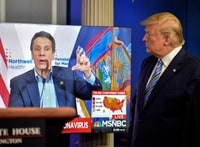
Governors step up
States became more dependent on the federal government and more under Washington’s thumb as the price for greater financial support. But governors learned this spring that the existing relationship was inadequate to meet the moment. Because of hesitation by the president, they had to act on their own, and those unilateral decisions put them in the spotlight as well as the hot seat.
Ohio’s Mike DeWine (R) was the first governor in the nation to close schools. Even earlier, before there were any confirmed cases of covid-19 in his state, he prohibited spectator attendance at a popular annual bodybuilding festival.
Disregarding a court decision that went against him, DeWine controversially postponed the state’s presidential primary on the eve of voting. He had hoped the courts would order the primary delayed, but his strategy of employing a friendly lawsuit to bring about the desired judicial ruling backfired.
“We pulled a judge who didn’t agree,” DeWine said. “It’s the luck of the draw. So at that point, I instructed my health director to issue a health order and that’s what she did. . . . It was a life-and-death issue.”
Pritzker was the second governor to order residents to stay at home, acting shortly after California Gov. Gavin Newsom (D) and a little ahead of New York Gov. Andrew M. Cuomo (D). Within a 24-hour period, the actions of those three governors put roughly 70 million Americans under orders to stay at home, with only a few exceptions.
The Centers for Disease Control and Prevention “was issuing guidance, but there was no leadership from Washington,” Pritzker said. “Is it hard to do? Sure. But it’s part of the job. That’s what leadership is. Leadership is stepping out front and showing people the direction they need to go that they don’t necessarily understand or agree with.”
Cuomo saw his state become the center of the pandemic, with more than 316,000 cases and more than 24,000 deaths. His daily news conferences became must-watch television, with a governor never known for his likability projecting empathy and realism while repeatedly challenging Washington to do more.
The briefings provided a contrast with Trump’s often-contentious daily sessions in the White House. Responding to Cuomo, Trump argued that New York did not need all it was asking for and that the federal government supplied New York with everything it did need and more.
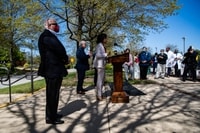
As chairman of the National Governors Association, Maryland Gov. Larry Hogan (R) has had to delicately navigate the relationship between the White House and his state, and the relationship between Washington and the governors collectively.
In his public comments about the relationship, Hogan has chosen his words diplomatically but has not hesitated to chart his own course. He shut down his state early — closing schools almost at the same time as Ohio did — and has made clear his differences with the president when he judged that events required doing so.
“The crisis demanded leadership and demanded action,” he said. “It wasn’t a time to debate federalism and philosophy, arguing about what powers should rest with the federal government or the state or Congress.
“Every day we waited, people lost their lives.”
[Denial and dysfunction plagued federal response]
Trump berated governors who criticized him. Governors learned that showing gratitude and praising the president were the price for federal cooperation and aid. Trump was particularly nasty toward Michigan Gov. Gretchen Whitmer (D) when she expressed frustration with Washington. He tweeted that Whitmer was “in way over her head, she doesn’t have a clue.”
Washington Gov. Jay Inslee (D) found himself as the first governor on the front lines when the virus began to savage a nursing home in the Seattle area. In pointed language, he begged for help from Washington. Trump called him “a snake” and suggested that Vice President Pence, a former governor of Indiana who chairs the White House coronavirus task force, stop dealing with Inslee.
“I hope this makes it into the story,” Inslee said. “The vice president has been continually helpful to us. He talks to us regularly. He has tried to ameliorate some of these problems. He has tried to remove some of the organizational underbrush. We have appreciated his efforts on this.”
Why was the relationship so bumpy? “Well, to be gracious, part of it is the fog of war,” Inslee said. “It’s people having to do 50 things in five minutes. . . . But it is no secret that the president did not have the intense focus he needed in the first month of this.”
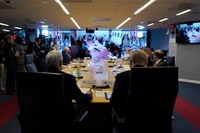
States vs. Washington
Governors have been in regular contact with the administration. Hogan said there have been nearly a dozen conference calls between the governors and Pence’s task force, calls that sometimes include the president.
They are freewheeling and helpful, he said. But he acknowledged that there have been “rough patches” where things “went off the rails.” He attributed that to mixed messaging from the White House and to the extraordinary nature of the pandemic.
“There is tension between what the role of the federal government should be and what are the roles of the states,” he added. “It’s an unprecedented crisis that no one has ever faced before. . . . The federal government was not prepared. States were not prepared. Hospitals were not prepared. Manufacturers were not prepared.”
Trump has lacked consistency in describing the federal government’s responsibilities. When governors were pleading for medical equipment and supplies weeks ago, Trump encouraged them to act on their own. “The federal government is not supposed to be out there buying vast amounts of items and then shipping,” he said. “You know, we’re not a shipping clerk.”
Jeh Johnson, the secretary of homeland security under President Barack Obama, said Trump had it backward. “He says he’s not a shipping clerk. Well, actually, he’s the shipping clerk in chief,” Johnson said.
The lack of preparedness and organization in Washington prompted governors to fend for themselves. Hogan, with the help of his Korean American wife Yumi Hogan, recently acquired 500,000 coronavirus test kits from South Korea. Massachusetts Gov. Charlie Baker (R), frustrated by obstacles thrown up by the federal government, was able to acquire 1.2 million N95 masks from China and had them flown to Boston on the airplane of the New England Patriots.
The Ohio company Battelle developed a process to sanitize N95 masks that allowed the masks to be used many times over, but company officials were having difficulty getting approval from the Food and Drug Administration. One Sunday morning, a frustrated DeWine called the White House and left a message on the switchboard, appealing for help. Later that day, the president called back “and it got moving,” he said. “It still had to go through the process, but it compressed the time.”
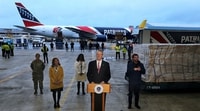
Illinois’ Pritzker was asked whether his public criticism of the White House had put his state at a disadvantage in getting supplies. “Every time I’ve been outspoken about something we needed, I’ve begun to receive calls from the White House and administration officials to try to help us out,” he said, adding he still hasn’t received everything he’s requested.
[What we know about delays in testing]
Tensions and frustrations continue. In March, as complaints about the federal government’s response mounted, Trump said, “I don’t take any responsibility at all.” He blamed others, including the Obama administration, for some of the shortages of tests and equipment.
More recently, the president claimed, with no basis in fact, that his “authority is total” to deal with the crisis, particularly on the timing for lifting state-ordered restrictions. The next day he backed down, acknowledging to governors in a conference call that the authority to make the decisions was theirs.
To Trump’s critics, that reversal was seen as another effort on his part to avoid responsibility, should things go wrong. “His idea of federalism is when it’s all going well, it’s us. When [it] hits the fan, it’s you,” said Michael Nutter, a former Democratic mayor of Philadelphia.
Testing remains a point of contention. Governors have contradicted the White House repeatedly on the availability of tests, which will be needed in huge numbers as businesses begin to reopen and people leave their homes. “It was a terrible crisis,” Hogan said of the shortage of tests. “It’s now better. But it’s not even close to where it needs to be.”
Governors have begun to work together through their joint conference calls and by forming regional alliances to coordinate when to lift restrictions. They have sought to project a united front when dealing with the administration. But the debate over the reopening of the economy has created divisions among them.
Georgia Gov. Brian Kemp (R) is turning his state into a laboratory with his decision to start opening businesses, including barber shops, nail salons, tattoo parlors, movie theaters and restaurants, more rapidly than other states, despite warnings that he is putting people at risk of the virus spreading.
If Kemp thought he would earn plaudits from a president who has been eager to restart the economy, he was wrong. Trump, in another whiplash moment, said last week that he took issue with the governor’s plan. “I told the governor very simply that I disagree with his decision, but he has to do what he thinks is right,” Trump said.
Governors have been making hard decisions for weeks, but equally difficult ones lie ahead. Up to now, governors who ordered the most stringent restrictions on their populations won praise and earned higher approval ratings. But the debate over reopening economies has put the trade-offs involved in those decisions at the forefront of a growing debate.
“There’s the old saying that war’s too important to be left to the generals,” said Mitchell E. Daniels Jr., a former governor of Indiana and now president of Purdue University. “Everyone is using the war analogy for this. Then it’s too important to be left entirely to the epidemiologists. . . . The trade-off problem is front and center. It took a while, but that’s what they’re grappling with.”
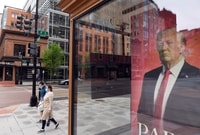
Unmet demand for action
State leaders have exercised their powers often to the fullest, but those powers still are limited. That has focused more attention on, and prompted considerable criticism of, the failure of the administration to exercise the federal government’s full powers.
Trump has complained that the federal stockpiles he inherited were inadequate to meet the pandemic’s demands. But Lisa Monaco, White House homeland security adviser under Obama, said those stockpiles were meant only to be a bridge. “It was always envisioned that [during a pandemic], the federal government would step in and activate the supply chain and manufacturing,” she said.
Only the federal government can use its convening authority and the Defense Production Act to set priorities and make a market for needed resources — and at a scale and a speed that a crisis demands. As Texas law professor Chesney explained, the federal government can compel industries to act in ways no state can do.
“[The president] can say the United States is purchaser number one,” Chesney said. “Let’s say the net amount of need is 100 masks. He can say the government will buy 100 masks and here’s what we’re going to pay for them and we’ll take possession on such and such a date.”
Leavitt said that in a pandemic, the federal government should focus as well on other things that states cannot do, such as stabilizing the economy, marshaling the development and distribution of a vaccine, becoming the clearing house for information and managing relations with other countries.
He said Washington also should coordinate among the states and supplement supplies as much as possible, but added that on this issue, no level of government comes off clean. “Emergency planners at every level have been aware for decades that we didn’t have a sufficient supply of ventilators,” he said. “There is plenty of blame to go around.”
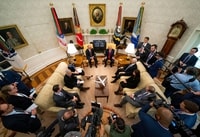
States have seen their own budgets hemorrhaging money because of the crisis, and governors are looking to Washington for financial relief. “As a governor, what you’re always hoping for from this kind of disaster is that you make all the decisions and have the feds pay for it,” said former New Jersey governor Chris Christie (R). “I’ve told the White House this. You can print money and they can’t.”
But Christie said this shouldn’t mean a blank check for the states. “Governors have to be held to account for also making some sacrifices and cutting spending in other areas that are not directly related to support for the covid-19 crisis,” he added. “Governors cannot be left with no hard choices.”
How this crisis will reshape relations between the states and the federal government already is on the minds of governors and others, who see it as a moment that could revive states in the public’s mind. States have formed regional groups, and some governors say that they are more likely to take steps to prepare and protect their states against a future pandemic, rather than just counting on Washington to be ready.
Janet Napolitano, a former governor of Arizona and secretary of homeland security in the Obama administration, said the relationship between Washington and the states in times of crisis should be like a smoothly running automobile. “The four wheels of a car need to spin in the same direction at the same time,” she said, something no one thinks has been the case in this battle.
Daniels said the pandemic has shown the vibrancy of federalism but nonetheless could end as another crisis that enlarges the federal government. “This [virus] thing does not manifest itself in the same way everywhere, and that’s an argument for a strong federal system and federal assistance that doesn’t try to proscribe every detail and constrain local responsiveness,” he said.
“On the other side,” he added, “as people have been observing, wars have tended to centralize power and lead to bigger central government that never quite goes back to the size it was.”
Hogan said this was no time for second-guessing the decisions that have been and are being made. In the meantime, he said, one thing seems clear: “In the biggest crisis of our lifetimes, governors were on the front lines and taking charge. States had to make decisions and use their powers in a way I don’t ever remember in my lifetime.”

